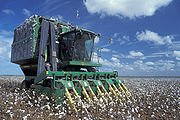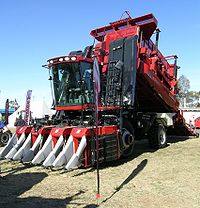
Cotton picker
Encyclopedia

Machine
A machine manages power to accomplish a task, examples include, a mechanical system, a computing system, an electronic system, and a molecular machine. In common usage, the meaning is that of a device having parts that perform or assist in performing any type of work...
that automates cotton
Cotton
Cotton is a soft, fluffy staple fiber that grows in a boll, or protective capsule, around the seeds of cotton plants of the genus Gossypium. The fiber is almost pure cellulose. The botanical purpose of cotton fiber is to aid in seed dispersal....
harvest
Harvest
Harvest is the process of gathering mature crops from the fields. Reaping is the cutting of grain or pulse for harvest, typically using a scythe, sickle, or reaper...
ing in a way that reduces harvest time and maximizes efficiency.
History
In 1850, Taylure and Paige made the first attempt to develop a mechanical cotton picker with the intent on replacing manual labor. Also in 1850, Samuel S. Rembert and Jedidiah Prescott patented a cotton-harvesting machine in Memphis, Tenn. The original patent notes that “Our cotton picking machine can be duplicated and extended to such a width as to embrace several rows of cotton at once.” Mechanical cotton pickers had no further inventions until the founder of Price Campbell Cotton Picker Corporation created one in 1889. John ApplebyJohn Appleby
John Francis Appleby was an American inventor who developed a knotting device to bind grain bundles with twine, which became the foundation for all farm grain binding machinery and was used extensively by all the major manufacturers of large grain harvesting machines in the late 19th and early...
patented a horse-drawn cotton picker in 1905.
Very little progress was made from then until 1924, when the Price-Campbell patents were purchased by International Harvester
International Harvester
International Harvester Company was a United States agricultural machinery, construction equipment, vehicle, commercial truck, and household and commercial products manufacturer. In 1902, J.P...
. Many experimental machines that were greatly improved from Price-Campbell's inventions were brought out during the period from 1924 until 1939. Most mechanical cotton pickers tried damaged both the plants and the bolls so badly that a repeat pick was no longer viable. Various companies and inventors claimed they had developed a mechanical cotton picker that did not damage the cotton crop while pick the bolls, but none did. The idea of mechanical cotton picking began to be practical in 1943, when International Harvester produced the first dozen of their successful commercial cotton pickers. Although there were many attempts to invent successful cotton pickers, their use was not made practical until the 1950s, and even then, it was not immediately implemented on most farm
Farm
A farm is an area of land, or, for aquaculture, lake, river or sea, including various structures, devoted primarily to the practice of producing and managing food , fibres and, increasingly, fuel. It is the basic production facility in food production. Farms may be owned and operated by a single...
s.
In 1980, John Deere
Deere & Company
Deere & Company, usually known by its brand name John Deere , is an American corporation based in Moline, Illinois, and the leading manufacturer of agricultural machinery in the world. In 2010, it was listed as 107th in the Fortune 500 ranking...
produced a 4-row cotton picker, the first in the industry. It was estimated that the unit would increase operators’ productivity by 85-95%.
Conventional picker

Manual labour
Manual labour , manual or manual work is physical work done by people, most especially in contrast to that done by machines, and also to that done by working animals...
. The current cotton picker is a self-propelled machine that removes cotton lint and seed (seed-cotton) from the plant at up to six rows at a time.
There are two types of pickers in use today. One is the "stripper" picker, primarily found in use in Texas. They are also found in Arkansas. It removes not only the lint from the plant, but a fair deal of the plant matter as well (such as unopened boll
Boll
The boll is an obsolete unit formerly used for grain.Boll or Böll is a German surname. Notable people with the surname include:* Buzz Boll , Canadian ice hockey player* Don Boll , American football player...
s). Later, the plant matter is separated from the lint through a process dropping heavier matter before the lint makes it to the basket at the rear of the picker. The other type of picker is the "spindle" picker. It uses rows of barbed spindle
Spindle (tool)
In machine tools, a spindle is a rotating axis of the machine, which often has a shaft at its heart. The shaft itself is called a spindle, but also, in shop-floor practice, the word often is used metonymically to refer to the entire rotary unit, including not only the shaft itself, but its bearings...
s that rotate at high speed and remove the seed-cotton from the plant. The seed-cotton is then removed from the spindles by a counter-rotating doffer and is then blown up into the basket. Once the basket is full the picker dumps the seed-cotton into a "module builder
Cotton module builder
The cotton module builder is a machine used in the harvest and processing of cotton. The module builder has helped to solve a logistical bottleneck by allowing cotton to be harvested quickly and compressed into large modules which are then tarped and temporarily stored at the edge of the field...
". The module builder creates a compact "brick" of seed-cotton, weighing in at approximately 21,000 lb (16 un-ginned bales), which can be stored in the field or in the "gin yard" until it is ginned. Each ginned bale weighs roughly 480 lb (218.2 kg).
In c.2008 the Case IH Module Express 625 was designed in collaboration with ginners and growers to provide a cotton picker with the ability to build modules while harvesting the crop.
An industry-exclusive on-board round module builder was offered by John Deere in 2007.

